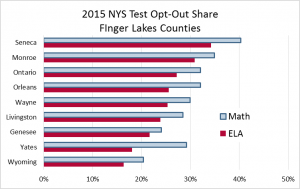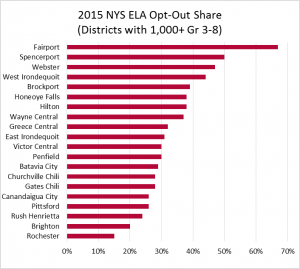
 Dissatisfaction with the NYS Education Department’s testing regime led many parents to allow their children to “opt-out” of state exams last spring. And now state leaders are engaged in a tactical withdrawal. With State Education Commissioner John King off to Washington—replaced by former Florida educator Mary Ellen Elia—Governor Cuomo is placing the blame for the botched Common Core rollout on State Ed’s doorstep and is calling for a reboot in time for his State of the State in January. Board of Regents Chair Meryl Tisch indicates her openness to changing the state’s teacher assessment system, the Annual Professional Performance Review (APPR).
Dissatisfaction with the NYS Education Department’s testing regime led many parents to allow their children to “opt-out” of state exams last spring. And now state leaders are engaged in a tactical withdrawal. With State Education Commissioner John King off to Washington—replaced by former Florida educator Mary Ellen Elia—Governor Cuomo is placing the blame for the botched Common Core rollout on State Ed’s doorstep and is calling for a reboot in time for his State of the State in January. Board of Regents Chair Meryl Tisch indicates her openness to changing the state’s teacher assessment system, the Annual Professional Performance Review (APPR).
 Elia has been touring the state on a charm offensive. While noting that the tests are not optional under state law, she recently announced that next year’s math test would have fewer multiple choice questions and the English language arts (ELA) test would include fewer reading passages.
Elia has been touring the state on a charm offensive. While noting that the tests are not optional under state law, she recently announced that next year’s math test would have fewer multiple choice questions and the English language arts (ELA) test would include fewer reading passages.
Why opt out?
The opt-out movement is a diverse coalition, which explains its size and rapid expansion.
- Dissatisfaction with testing is a longstanding complaint of progressives, who are convinced that any “standardized” assessment fails to capture the unique achievements of individual children.
- Most teachers believe in assessment, but will fight against imperfect tests that influence how money flows to schools or, even worse, how individual teachers are graded themselves and rewarded. And testing is hardly an exact science—all tests are imperfect. The new APPR regime, as modified in the 2015 budget process, raised the stakes for teachers in a big way, prompting NYS United Teachers (NYSUT) to vigorously encourage parents to opt-out.
- Parents want to shield their children from unnecessary anxiety. If they become convinced that the tests are seriously flawed, then the anxiety indeed seems unnecessary.
- Administrators, teachers and parents all worry about the time testing can take away from instruction. Again, if they don’t have confidence in the tests, any time spent on them is wasted.
- Finally, the Common Core (CC) standards have become a magnet for criticism from both ends of the political spectrum, although for different reasons. To CC opponents, anything linked to the standards is tainted.
2015 became a “perfect storm” for the state tests. There is a lot of blame to go around.
- The Common Core rollout was badly handled—State Ed expected teachers and students to move to an entirely different “scope and sequence” of material without any “ramp-up,” e.g. 6th graders were expected to tackle CC math that was built upon K-5 CC preparation.
- Governor Cuomo over-played his hand at budget time, triggering the wrath of NYSUT and school administrators alike.
- The APPR process had spawned a raft of district-designed tests. Layered on the state tests, parents felt that testing had become all-consuming.
What happened in the Finger Lakes?
The opt-out movement captured a lot of adherents in the Finger Lakes region (defined here as Genesee, Livingston, Monroe, Ontario, Orleans, Seneca, Wayne, Wyoming, and Yates counties). Topping the list is suburban Fairport, led (on an interim basis) by activist Superintendent Bill Cala. Only a third of students took either the ELA or math exams in that district.
Looking at the 20 districts with more than 1,000 enrolled in grades 3-8, all but eight saw 30% or more students opt out. The opt-out rate was much lower among the remaining (largely rural) districts: Of 60 districts with fewer than 1,000 in grades 3-8, only 11 saw opt-out rates of 30% or more. Overall, 29% of all K-8 students in the Finger Lakes opted out of the ELA test and 33% opted out of the math test.
Opt-outs lower performing
Given the number and share of opt-outs in 2015, the state’s effort at tracking student achievement has taken a hit. What do we know about the bias introduced by the opt-out movement? Are 2015’s numbers biased up—because low achieving students skipped the test—or are they biased down, because high achieving students opted out?
Some speculated that the kind of activism that would prompt a family to choose to opt-out would be more prevalent among higher income households. Indeed, the opt-out rate in New York’s high poverty cities was significantly lower than in more prosperous, suburban districts. In the Finger Lakes, Rochester’s opt-out rate was among the lowest in region at 15%.
NYS Education analysts answered the question. By reporting 2014 test achievement for students opting out of the 2015 tests, it appears that the opt-outs were lower performing, on average. In the Finger Lakes, the opt-outs passed the ELA at a rate of 23% in 2014, much lower than the overall pass rate of 36%. The same relationship is apparent in the math test: The opt-outs passed the 2014 test at a rate of 36%, lower than the 42% rate observed overall in 2014.
With one big exception: These estimates exclude the Rochester City School District. State Ed data tell us that RCSD’s 2015 opt-outs were higher performing than the average, but in math only: 21% of opt-out students passed the math test in 2014 v. 8% overall. There was no difference between the opt-outs and the overall average for ELA.
What’s the Future Hold?
The response of the Governor, the Board of Regents and the Education Commissioner shows that the message sent by the opt-outs was clearly heard. The question for the 2016 tests is whether the civil disobedience of opting out will ebb or flow in response. Elia has already announced that the tests will be cut back. If that’s not enough and the movement grows, it may be hard to justify the continued disruption and expense of statewide testing. New York’s vaunted state standards—which existed long before Common Core—will be at risk. Will every district go back to developing its own standards and its own curricula? Will student achievement no longer play a role in evaluating teacher effectiveness? Check back next summer.

